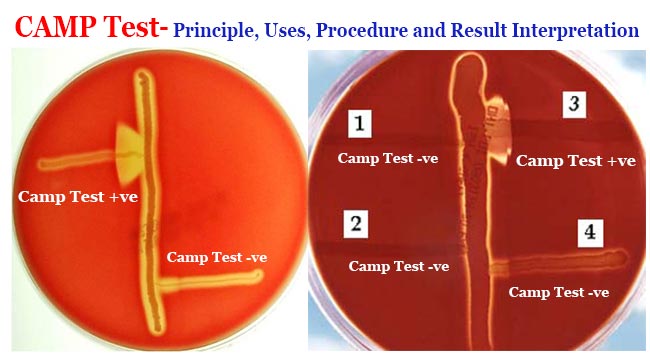CAMP test is used to distinguish the species Streptococcus agalactiae from other species of beta-hemolytic Streptococcus. S. agalactiae, a member of the Lancefield Group B streptococci, is one of the causative agents of mastitis in cows. CAMP is an acronym for the authors of this test (Christie, Atkinson, Munch, and Peterson) which was identified in 1944.
Principle of CAMP test
Certain organisms (including group B streptococci) produce a diffusible extracellular hemolytic heat-stable protein (CAMP factor) that acts synergistically with the beta-lysin of Staphylococcus aureus to cause enhanced lysis of red blood cells. The group B streptococci are streaked perpendicular to a streak of S. aureus on sheep blood agar. A positive reaction appears as an arrowhead zone of hemolysis adjacent to the place where the two streak lines come into proximity.
The hemolytic activity of the beta-hemolysin produced by most strains of Staphylococcus aureus is enhanced by extracellular protein produced by group B streptococci. Interaction of the beta-hemolysin with this factor causes “synergistic hemolysis,” which is easily observed on a blood agar plate. This phenomenon is seen with both hemolytic and non-hemolytic isolates of group B streptococci.
Uses of CAMP test
- It is used to distinguish the species Streptococcus agalactiae from other species of beta-hemolytic Streptococcus.
- It is used to identify Listeria monocytogenes which also produces a positive CAMP reaction.
Procedure of CAMP test
- Streak a beta-lysin–producing strain of aureus down the center of a sheep blood agar plate.
- The streptococcal streak should be 3 to 4 cm long.
- Streak test organisms across the plate perpendicular to the aureus streak within 2 mm. (Multiple organisms can be tested on a single plate).
- Incubate at 35°-37°C in ambient air for 18-24 hours.
- Group B streptococci and a few other beta-streptococci produce an enhancement of the ß-lysin activity of the aureus strain.
Result Interpretation of CAMP test

Positive: Enhanced hemolysis is indicated by an arrow head-shaped zone of beta-hemolysis at the junction of the two organisms.
Negative: No enhancement of hemolysis.
Quality Control for CAMP test
Positive: Streptococcus agalactiae (ATCC13813)—enhanced arrowhead hemolysis.
Negative: Streptococcus pyogenes (ATCC19615)—beta-hemolysis without enhanced arrowhead formation.
Limitations of CAMP test
- A small percentage of group A streptococci may have a positive CAMP reaction.
- Some Group A Streptococcal will be CAMP test positive if the plate is incubated in a candle jar in an atmosphere or under anaerobic conditions. Therefore, ambient air incubation should be done.
- The test should be limited to colonies with the characteristic group B streptococci morphology and narrow zone beta-hemolysis on sheep blood agar.
- Extended incubation times or elevated incubation temperatures may give false-positive results.
- Sheep blood agar plates are only used. Human, horse, rabbit, or guinea pig blood plates will not give a proper reaction.
- Colonies of Listeria monocytogenes have a narrow zone of beta-hemolysis on sheep blood agar and may be confused with group B beta-hemolytic streptococci, if catalase and gram stain are not performed.
References
- https://catalog.hardydiagnostics.com/cp_prod/Content/hugo/CAMPSpotTestReagent.htm
- https://en.wikipedia.org/wiki/CAMP_test
- Murray, P.R., Baron, E. J., Jorgensen, J.J., Pfaller, M.A., and Yolken, R.H. Manual of Clinical Microbiology, 8th ed. ASM Press: Washington, DC, 2003.
- Bailey and Scott’s Diagnostic Microbiology.
- Mackie and McCartney Practical Medical Microbiology.
- Topley and Wilson’s Microbiology and Microbial Infection. Bacteriology Volume 2.
- Manual of Clinical Microbiology, Volume 1, 8th ASM Press.

You could also use novobiocin. Streptococcus agalactiae is lightly susceptible. So what you can do in your lab is just inoculate another blood agar with a disk of novobiocin. After incubation you just be seeing a slightly inhibition zone around the novobiocine.
What the best medium may i use to isolate S.a galactiae from females urine? With blad agar, i have no growth